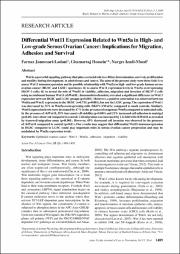| dc.date.accessioned | 1399-07-08T17:57:11Z | fa_IR |
| dc.date.accessioned | 2020-09-29T17:57:11Z | |
| dc.date.available | 1399-07-08T17:57:11Z | fa_IR |
| dc.date.available | 2020-09-29T17:57:11Z | |
| dc.date.issued | 2014-03-01 | en_US |
| dc.date.issued | 1392-12-10 | fa_IR |
| dc.identifier.citation | (2014). Differential Wnt11 Expression Related to Wnt5a in High- and Low-grade Serous Ovarian Cancer: Implications for Migration, Adhesion and Survival. Asian Pacific Journal of Cancer Prevention, 15(3), 1489-1495. | en_US |
| dc.identifier.issn | 1513-7368 | |
| dc.identifier.issn | 2476-762X | |
| dc.identifier.uri | http://journal.waocp.org/article_28776.html | |
| dc.identifier.uri | https://iranjournals.nlai.ir/handle/123456789/32908 | |
| dc.description.abstract | Wnt is a powerful signaling pathway that plays a crucial role in cell fate determination, survival, proliferationand motility during development, in adult tissues and cancer. The aims of the present study were three fold: i) toassess Wnt11 immunoexpression and its possible relationship with Wnt5a in high- and low-grade human serousovarian cancer (HGSC and LGSC) specimens; ii) to assess Wnt11 expression levels in Wnt5a overexpressingSKOV-3 cells; iii) to reveal the role of Wnt11 in viability, adhesion, migration and invasion of SKOV-3 cellsusing recombinant human Wnt11 (rhWnt11). Immunohistochemistry revealed a significant difference in Wnt11expression between HGSC and LGSC groups (p=0.001). Moreover, a positive correlation was observed betweenWnt5a and Wnt11 expression in the HGSC (r=0.713, p=0.001), but not the LGSC group. The expression of Wnt11was decreased by 35% in Wnt5a overexpressing cells (SKOV-3/Wnt5a) compared to mock controls. SimilarlyWnt11 expression levels were decreased by 47% in the presence of exogenous Wnt5a compared to untreated cells.In the presence of rhWnt11, 31% increased cell viability (p<0.001) and 21% increased cell adhesion to matrigel(p<0.01) were observed compared to control. Cell migration was increased by 1.6-fold with rhWnt11 as revealedby transwell migration assay (p<0.001). However, 45% decreased cell invasion was observed in the presenceof rhWnt11 compared to control (p<0.01). Our results may suggest that differential Wnt11 immunoexpressionin HGSC compared to LGSC could play important roles in serous ovarian cancer progression and may bemodulated by Wnt5a expression levels. | en_US |
| dc.format.extent | 1307 | |
| dc.format.mimetype | application/pdf | |
| dc.language | English | |
| dc.language.iso | en_US | |
| dc.publisher | West Asia Organization for Cancer Prevention (WAOCP) | en_US |
| dc.relation.ispartof | Asian Pacific Journal of Cancer Prevention | en_US |
| dc.subject | Epithelial Ovarian Cancer | en_US |
| dc.subject | Wnt11 | en_US |
| dc.subject | Wnt5a | en_US |
| dc.subject | Adhesion | en_US |
| dc.subject | migration | en_US |
| dc.subject | viability | en_US |
| dc.title | Differential Wnt11 Expression Related to Wnt5a in High- and Low-grade Serous Ovarian Cancer: Implications for Migration, Adhesion and Survival | en_US |
| dc.type | Text | en_US |
| dc.citation.volume | 15 | |
| dc.citation.issue | 3 | |
| dc.citation.spage | 1489 | |
| dc.citation.epage | 1495 | |





